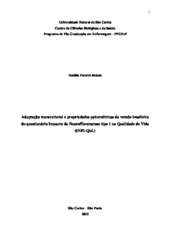Adaptação transcultural e propriedades psicométricas da versão brasileira do questionário Impacto da Neurofibromatose tipo 1 na Qualidade de Vida (INF1-QoL)
Abstract
Introduction: Neurofibromatosis type 1 (NF1) is an autosomal dominant multisystem disorder with numerous dermatological manifestations and cosmetic implications. The disease affects both sexes and its global incidence is estimated at 1 in 2,500 births. NF1 has virtually complete penetrance after childhood, although its expressiveness is highly variable. The cumulative risk of malignancy in individuals with NF1 up to age 50 years has been estimated at 20 to 39%. The complications of NF1 can substantially affect the quality of life, which led to the development of a specific questionnaire to assess the quality of life of patients with NF1, entitled INF1-QoL (Impact of NF1 on Quality of Life) and published in 2017 by a group of UK researchers. The INF1-QoL is a 14-item questionnaire with answers on a scale of 0 to 3. The maximum potential score for the questionnaire is 42, with higher scores indicating a worse quality of life. In addition, the questionnaire contains a final open question about the impact of NF1 on quality of life. The original INF1-QoL, in English, has good psychometric properties and has been considered suitable as an assessment tool both in clinical practice and in therapeutic trials. Aims: To contribute to the investigation of the impact of NF1 on the quality of life of affected individuals, through (1) the development of a NF1 visibility self-evaluation scale, (2) the cross-cultural adaptation of the INF1-QoL into Portuguese, and (3) the analysis of the measurement properties of the INF1-QoL in a sample of Brazilian individuals with NF1. Methodology: Descriptive and transversal research that used mixed methods (quantitative and qualitative). Firstly, a scale of self-evaluation on NF1 visibility was developed, which could be assigned by the own individual, and that categorized people with NF1 concerning the visibility of the disease into 3 degrees: mild, moderate, and severe. Secondly, a cross-cultural adaptation of the INF1-QoL was carried out, following the steps recommended for instruments in the health area: translation, synthesis of translations, back-translation, semantic validation, linguistic review by experts and people with NF1, and final review by an advisory committee. Finally, a pre-test was carried out, from which the psychometric properties of the INF1-QoL in Portuguese were investigated: floor and ceiling effects, reliability (Cronbach's alpha index), internal construct validity (exploratory factor analysis), and external construct validity (convergent validity and known-groups validity). Non-parametric tests were used to analyze the relation of the variable “quality of life” concerning the sociodemographic and clinical factors of the individuals; the significance level adopted was 5%. In addition, the answers to the last question of the INF1-QoL were submitted for thematic analysis, and the themes were discussed through a comprehensive and interpretive approach. Results: Three initial translations of the INF1-QoL into Portuguese were performed by independent translators; later, the synthesis of the translations was carried out, and the INF1-QoL was back-translated into the original language; the translated and back-translated versions were semantically evaluated by the advisory committee and by one of the authors of the original questionnaire; linguistic validation of the INF1-QoL was carried out by 20 specialists (doctors and nurses) and by 33 people with NF1, to establish the final version of the INF1-QoL in Portuguese. The pre-test included 101 adults with NF1 aged 18 to 59 years, with a mean age of 35.54 years (9.63) and a female predominance (n = 84, 83.16%). The average total score of the INF1-QoL was 10.62 (±5.63), with a median of 10, a minimum value of 0, a maximum of 31 points, a floor effect of 2%, and a 0% ceiling effect. The results of Cronbach's alpha showed high reliability of the INF1-QoL questionnaire as a whole (0.8009) and also of each of its questions. The factor analysis indicated two latent factors as being the most representative of the dataset and explaining 49% of the variance of the results. The factor structure presented adequate composite reliability indices, replicability estimates, and adjustment indices. Convergent construct validity was analyzed, indicating a statistically significant positive correlation between the INF1-QoL score and the degree of disease visibility (rho=0.218; p=0.028). The INF1-QoL was able to discriminate between the subgroups of individuals according to educational level (p=0.003), evidencing the known-group validity of the instrument. From the qualitative analysis, we discerned nine main themes: (1) uncertainties regarding the future; (2) irritability and nervousness; (3) physical pain and limitations; (4) depression and self-esteem issues; (5) concern about the risk of recurrence; (6) learning difficulties; (7) low disease appreciation; (8) sleep problems; and (9) prejudice and confusion with contagious disease. Conclusions: The scale of self-evaluation on NF1 visibility developed and evaluated in this study proved to be, a priori, a useful instrument for self-classifying the visibility of NF1. The INF1-QoL questionnaire was translated, adapted, and validated in the Brazilian context, allowing future studies on quality of life in people with NF1 to be conducted and providing health professionals with instruments to care for patients with NF1.
Collections
The following license files are associated with this item:

